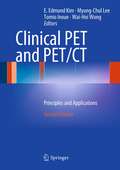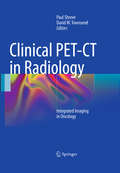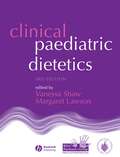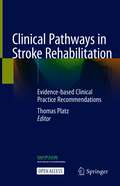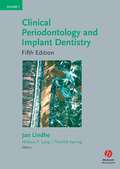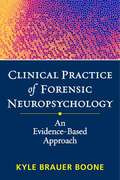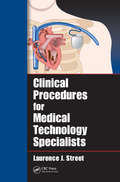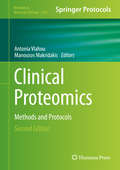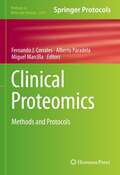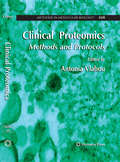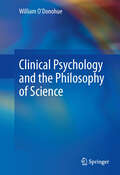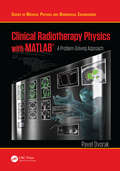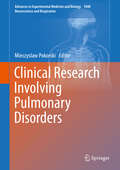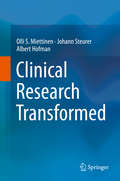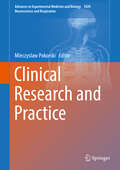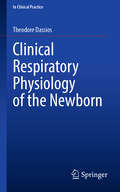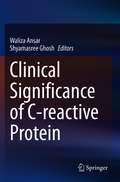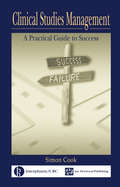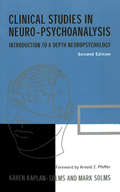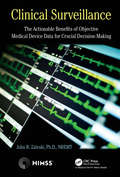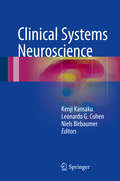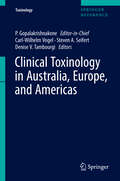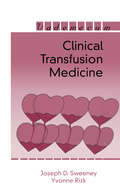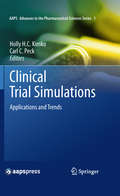- Table View
- List View
Clinical PET and PET/CT: Principles and Applications
by Tomio Inoue E. Edmund Kim Wai-Hoi Wong Myung-Chul LeeClinical PET and PET/CT, 2nd Edition presents a valuable overview of the basic principles and clinical applications of PET and PET/CT. Emphasis is placed on the familiarization of normal distribution, artifacts, and common imaging agents such as FDG in conjunction with CT, MRI, and US to establish the clinical effectiveness of PET and PET/CT. Practical information about updated PET and PET/CT scanners, imaging processing, correlation, and quantification of PET and PET/CT measurements is also presented. This book is divided into two sections, the first half dealing with the basic principles of PET and PET/CT for instrumentation, fusion, radiopharmaceuticals, radiosynthesis, safety, and cost analysis. The second part of this volume presents chapters on the clinical techniques and applications of PET and PET/CT for common oncologic, cardiologic, and neurologic diseases. Numerous full color images provide comprehensive coverage on essential clinical PET and PET/CT studies.
Clinical PET-CT in Radiology: Integrated Imaging in Oncology
by Paul Shreve David W. TownsendThis book is specifically designed to meet the needs of practicing radiologists by offering a practical, unified approach to PET-CT. It details how to effectively apply PET-CT in patient management. Written by radiologists who fully appreciate and understand both PET and CT, the book details an integrated understanding of PET-CT as a combined modality. Clinical topics include PET-CT of thoracic malignancies, melanoma, and breast cancer. In addition, the book reinforces fundamental concepts, such as the role of imaging diagnosis in disease management.
Clinical Paediatric Dietetics
by Margaret Lawson Vanessa ShawThis standard work has been comprehensively revised and expanded to meet the needs of the modern practising and student dietitian.In tune with current trends, a greater emphasis has been placed on public health issues such as the treatment of childhood nutritional disorders in the community, including obesity and faltering growth. The book now also contains a dedicated chapter on the important issue of allergy prevention.* Edited by leading experts at Great Ormond Street and the Institute of Child Health* Officially supported by the British Dietetic Association* Written for dietitians, by dietitiansWith worked examples of dietary management given throughout, Clinical Paediatric Dietetics is an indispensable guide for all those involved in the nutritional treatment of children.
Clinical Pathways in Stroke Rehabilitation: Evidence-based Clinical Practice Recommendations
by Thomas PlatzThis open access book focuses on practical clinical problems that are frequently encountered in stroke rehabilitation. Consequences of diseases, e.g. impairments and activity limitations, are addressed in rehabilitation with the overall goal to reduce disability and promote participation. Based on the available best external evidence, clinical pathways are described for stroke rehabilitation bridging the gap between clinical evidence and clinical decision-making. The clinical pathways answer the questions which rehabilitation treatment options are beneficial to overcome specific impairment constellations and activity limitations and are well acceptable to stroke survivors, as well as when and in which settings to provide rehabilitation over the course of recovery post stroke. Each chapter starts with a description of the clinical problem encountered. This is followed by a systematic, but concise review of the evidence (RCTs, systematic reviews and meta-analyses) that is relevant for clinical decision-making, and comments on assessment, therapy (training, technology, medication), and the use of technical aids as appropriate. Based on these summaries, clinical algorithms / pathways are provided and the main clinical-decision situations are portrayed. The book is invaluable for all neurorehabilitation team members, clinicians, nurses, and therapists in neurology, physical medicine and rehabilitation, and related fields. It is a World Federation for NeuroRehabilitation (WFNR) educational initiative, bridging the gap between the rapidly expanding clinical research in stroke rehabilitation and clinical practice across societies and continents. It can be used for both clinical decision-making for individuals and as well as clinical background knowledge for stroke rehabilitation service development initiatives.
Clinical Periodontology and Implant Dentistry
by Niklaus P. Lang Thorkild Karring Jan LindheThe fifth edition of Clinical Periodontology and Implant Dentistry brings to its readers another iteration of the unrivalled, unparalleled work on the specialty of periodontics. The editors have brought together contributions from experts all over the world to provide the reader with a comprehensive, cohesive text that fuses scholarship and science with clinical instruction and pragmatism. With an increase in length of approximately 25% and 15 new chapters, the new edition of Clinical Periodontology and Implant Dentistry runs the gamut of sub-disciplines and topics within periodontics and implant dentistry, supporting an intellectually and internationally inclusive approach.
Clinical Practice of Forensic Neuropsychology
by Kyle Brauer BooneWritten by a foremost expert in the field, this hands-on, evidence-based guide describes how to conduct a comprehensive forensic neuropsychological evaluation and provide expert testimony. All steps are covered--from selecting, scoring, and interpreting tests to writing reports and responding to cross-examination with special attention to assessing noncredible performance. The book identifies seven common flaws of forensic neuropsychological reports and shows how to avoid them. Excerpts from testimony transcripts illustrate ways neuropsychologists can protect their reports from attack. Also featured are case illustrations and a sample report.
Clinical Procedures for Medical Technology Specialists
by Laurence J. StreetAs healthcare becomes more complex, the integration of all members of the team becomes even more important. Part of this integration requires that all team members have a grasp of the fundamentals of the medical and surgical treatments they are involved in. Written specifically for paramedical professionals who support doctors and nurses, Clinical
Clinical Proteomics: Methods and Protocols (Methods in Molecular Biology #1243)
by Antonia Vlahou Manousos MakridakisThis second edition expands upon the previous edition with current, detailed developments in the field and brings together a multi-disciplinary team of leading researchers to provide their latest protocols for clinical proteomics analysis. Written in the highly successful Methods in Molecular Biology series format, chapters include introductions to their respective topics, lists of the necessary materials and reagents, step-by-step, readily reproducible laboratory protocols, and tips on troubleshooting and avoiding known pitfalls. Authoritative and Practical, Clinical Proteomics: Methods and Protocols, Second Edition presents approaches that will serve as a reliable guide to researchers, including clinicians, chemists, molecular biologists, bioinformaticians and computational, biologists, and investigators working on biomarker development.
Clinical Proteomics: Methods and Protocols (Methods in Molecular Biology #2420)
by Fernando J. Corrales Alberto Paradela Miguel MarcillaThis detailed volume explores techniques in clinical proteomics, an emerging discipline aimed at deciphering the molecular mechanisms underlying the progression of diseases and at identifying new biomarkers and therapeutic targets to expand the physicians’ toolbox for precision medicine-based patient care. From sample processing to multi-omics approaches, the book provides straight-forward protocols on a wide array of vital areas of study. Written for the highly successful Methods in Molecular Biology series, chapters include introductions to their respective topics, lists of the necessary materials and reagents, step-by-step, readily reproducible protocols, and tips on troubleshooting and avoiding known pitfalls. Authoritative and practical, Clinical Proteomics: Methods and Protocols serves as an ideal guide for researchers working to expand upon the knowledge base needed to push forward toward a more personalized version of medicine.
Clinical Proteomics: Methods and Protocols (Methods in Molecular Biology #428)
by Antonia VlahouIn this book, a select group of researchers has contributed their state-of-the-art methodologies on protein profiling and identification of disease biomarkers in tissues, microdissected cells and body fluids. The book integrates biochemistry, pathology, analytical technology, bioinformatics, and proteome informatics. Experimental approaches are thoroughly detailed and explained through a step-by-step instructional format that ensures successful results.
Clinical Psychology and the Philosophy of Science
by William O'DonohueThe motivation for this volume is simple. For a variety of reasons, clinical psychologists have long shown considerable interest in the philosophy of science. When logical positivism gained currency in the 1930s, psychologists were among the most avid readers of what these philosophers had to say about science. Part of the critique of Skinner's radical behaviorism and thus behavior therapy was that it relied on, and thus was logically dependent on, the truth of logical positivism--a claim decisively refuted both historically and logically by L.D. Smith (1986) in his important Behaviorism and Logical Positivism: A Reassessment of the Alliance.
Clinical Pulmonary Research (Advances in Experimental Medicine and Biology #1114)
by Mieczyslaw PokorskiThis book describes various aspects of current scientific interest in clinical developments and management of pulmonary pathologies. Non-communicable and communicable disorders are tackled. Chronic disorders of an inflammatory background, such as COPD and asthma, often overlapping, diagnostically and therapeutically misguided and always difficult to manage, are in focus due to an increasing prevalence across the age range. The authors dwell on the disease management, exacerbations, care and therapy, taking into account all too often overlooked psychosomatic determinants. Novel markers of pulmonary sarcoidosis, also an inflammatory disease, albeit of unknown etiology, are described. The outstanding lung images of cystic fibrosis are presented in another chapter. Finally, there are reports on the extent of the influenza scourge in Poland during the past 2016/2017 epidemic season. The book is addressed to clinicians, family physicians, medical scholars, and all professionals engaged in the preservation of respiratory health.
Clinical Radiotherapy Physics with MATLAB: A Problem-Solving Approach (Series in Medical Physics and Biomedical Engineering)
by Pavel DvorakThe first MATLAB® programming book written specifically for clinical radiotherapy medical physicists and medical physics trainees, this much-needed book teaches users how to create their own clinical applications using MATLAB®, as a complement to commercial software particularly when the latter does not cover specific local clinical needs. Chapters explore key radiotherapy areas such as handling volumes, 3D dose calculation, comparing dose distributions, reconstructing treatment plans and their summations, and automated tests for machine quality assurance. Readers will learn to independently analyse and process images, doses, structures, and other radiotherapy clinical data to deal with standard and non-standard situations in radiotherapy. This book will also significantly improve understanding of areas such as data nature, information content, DICOM RT standard, and data flow. It will be an invaluable reference for students of medical physics, in addition to clinical radiotherapy physicists and researchers working in radiotherapy. Features: Includes real clinical medical physics applications derived from actual clinical problems Provides commented MATLAB® scripts working with sample data and/or own data matching input requirements Promotes critical thinking and practical problem solving skills
Clinical Research Involving Pulmonary Disorders (Advances in Experimental Medicine and Biology #1040)
by Mieczyslaw PokorskiThis book presents the current trends and state of the art solutions addressing various issues related to pulmonary disorders. Diagnostic and therapeutic challenges are tackled, starting with the noncommunicable diseases of sarcoidosis and granulomatosis with polyangiitis. Pulmonary involvement, practically unavoidable, runs an insidious course, and is often occulted by systemic symptoms. The establishment of a firm diagnosis, with a precision no one could oppugn, is difficult. Other issues pertain to quality of life, disease preventive measures, and the move toward personal health care in chronic sufferers from multiple conditions in later life. There is also an update on the prevalence and diagnostic and treatment challenges of extrapulmonary tuberculosis. In addition, the place of neuroproteomics in modern clinical practice is presented. The practical insights emphasize the role of science in advancing biomedical knowledge and care. The book is addressed to researchers and practitioners, and allied health care professionals engaged in effective patient care and therapy.
Clinical Research Transformed
by Olli S. Miettinen Johann Steurer Albert HofmanIn this Information Age, the practices of clinical medicine should no longer be based on what clinical doctors actively know. Rather, all of the importantly practice-relevant knowledge should not only already exist but also be codified in cyberspace, in directly practice-guiding 'expert systems' -- for the benefit of both doctors and patients everywhere. Each of these systems (discipline-specific) would, prompted by a particular type of case presentation, present the doctor a questionnaire specific to cases of the type at issue, and document the doctor's answers to the questions. If at issue would be a case of complaint about a (particular type of) sickness, the system would translate the resulting diagnostic profile of the case into the corresponding probabilities of the illnesses to be considered. Similarly, if at issue would be an already-diagnosed case of a particular illness, the system would ask about, and record, the relevant elements in the prognostic profile of the case and then translate this profile into the probabilities of various outcomes to be considered, probabilities specific to the choice of treatment and prospective time in addition to that profile. And besides, these systems would analogously address the causal origin -- etiogenesis -- of cases of particular types of illness. While the requisite knowledge-base for these systems -- notably for the probabilities in them -- has not been addressed by such 'patient-oriented' clinical research as has been conducted (very extensively) up to now, this book delineates the nature of the suitably-transformed research (gnostic). The critically-transformative innovation in the research is the studies' focus on Gnostic Probability Functions -- dia-, etio-, and prognostic -- in the framework of logistic regression models. This book also presents a vision of how this critically-transformative research would most expeditiously be provided for and also conducted, among select sets of academic teaching hospitals.
Clinical Research and Practice (Advances in Experimental Medicine and Biology #1020)
by Mieczyslaw PokorskiThis book is a blend of medical research and clinical practice. Advancements in practice are inextricably bound to have research underpinnings. The articles highlight a range of practical topics. The respiratory tract is upfront as the first line of defense of the organism. Virological and bacteriological aspects of the infections that continue to be a scourge worldwide, influenza and tuberculosis, are dealt with. Sleep disordered breathing is another hot topic. Allergy and atopy, and the role of nutraceuticals in providing anticancer benefits due to the inhibitory effects on tumor growth and angiogenesis are referred to. Other chapters describe the use of mesenchymal stem cells for regeneration of the worn away cartilage tissue in the knee. The assessment and management of cognitive decline, sarcopenia and frailty of old age also figure prominently in the texts. The book is an attempt to demonstrate the viability of a bench-to-bedside design in point-of-care patient applications. Hopefully, it will be a source of information on interdisciplinary medical research advancements, addressing the needs of medical professionals, from scientists to clinicians and allied health professionals.
Clinical Respiratory Physiology of the Newborn (In Clinical Practice)
by Theodore DassiosThis book provides a practical overview of the clinical and scientific knowledge relevant to the respiratory physiology of the newborn infant. Clear and concise chapters examine topics such as the mechanics of breathing, the neonatal respiratory system at critical extremes and lung function tests in neonates. Clinical Respiratory Physiology of the Newborn is an indispensable resource for fellows in neonatology and paediatric intensive care as well as senior consultants within the same specialities seeking a complete bedside guide to this evolving topic in clinical practice.
Clinical Significance of C-reactive Protein
by Waliza Ansar Shyamasree GhoshThis book explores the latest developments in the field the acute phase protein (APP), C-reactive protein or CRP in different diseases, highlighting the structural and functional aspects of CRP in disease biology.Divided into 5 sections, the book examines important topics such as the role of CRP in neurodegenerative, cardiac and parasitic diseases, as well as in cancer and inflammatory bowel disease, and the expression of CRP in pediatric respiratory diseases. In addition it discusses the clinical role of CRP in diagnostics and therapeutics, sepsis, ICU and ITU patients, and also as a primary marker for inflammation. Given its scope, this book will appeal to scholars in various fields of medicine and biology.
Clinical Studies Management: A Practical Guide to Success
by Simon CookWhat if you were suddenly in charge? After the initial excitement of a "battlefield promotion" wears off, you need to get in the trenches and get the job done. And if you are already in the trenches, you need quick access to information that will make your job easier. A comprehensive desk reference and guide, Clinical Studies Management: A Practica
Clinical Studies in Neuro-psychoanalysis: Introduction to a Depth Neuropsychology (Journal Of The American Psychoanalytic Association Ser. #No. 5)
by Mark Solms Karen Kaplan-SolmsWhen the first edition of Clinical studies in Neuro-Psychoanalysis was published in 2000, it was hailed as a turning point in psychoanalytic research. It is now relied on as a model for the integration of neuroscience and psychoanalysis. It won the NAAP's Gradiva Award for Best Book of the Year 2000 (Science Category) and Mark Solms received the International Psychiatrist Award 2001 at the American Psychiatric Association's annual meeting. The authors have added a glossary of key terms of this edition to aid their introduction to depth neuropsychology. 'Freud, in his 1895 Project for a Scientific Psychology, attempted to join the emerging discipline of psychoanalysis with the neuroscience of his time. But that was a hundred years ago, when the neuron had only just been described, and Freud was forced - through lack of pertinent knowledge - to abandon his project. We have had to wait many decades before the sort of data which Freud needed finally became available. Now, these many years later, contemporary neuroscience allows for the resumption of the search for correlations between these two disciplines.
Clinical Surveillance: The Actionable Benefits of Objective Medical Device Data for Critical Decision-Making (HIMSS Book Series)
by John R. ZaleskiFor more than a decade, the focus of information technology has been on capturing and sharing data from a patient within an all-encompassing record (a.k.a. the electronic health record, EHR), to promote improved longitudinal oversight in the care of the patient. There are both those who agree and those who disagree as to whether this goal has been met, but it is certainly evolving. A key element to improved patient care has been the automated capture of data from durable medical devices that are the source of (mostly) objective data, from imagery to time-series histories of vital signs and spot-assessments of patients. The capture and use of these data to support clinical workflows have been written about and thoroughly debated. Yet, the use of these data for clinical guidance has been the subject of various papers published in respected medical journals, but without a coherent focus on the general subject of the clinically actionable benefits of objective medical device data for clinical decision-making purposes. Hence, the uniqueness of this book is in providing a single point-of-capture for the targeted clinical benefits of medical device data--both electronic- health-record-based and real-time--for improved clinical decision-making at the point of care, and for the use of these data to address and assess specific types of clinical surveillance. Clinical Surveillance: The Actionable Benefits of Objective Medical Device Data for Crucial Decision-Making focuses on the use of objective, continuously collected medical device data for the purpose of identifying patient deterioration, with a primary focus on those data normally obtained from both the higher-acuity care settings in intensive care units and the lower-acuity settings of general care wards. It includes examples of conditions that demonstrate earlier signs of deterioration including systemic inflammatory response syndrome, opioid-induced respiratory depression, shock induced by systemic failure, and more. The book provides education on how to use these data, such as for clinical interventions, in order to identify examples of how to guide care using automated durable medical device data from higher- and lower-acuity care settings. The book also includes real-world examples of applications that are of high value to clinical end-users and health systems.
Clinical Systems Neuroscience
by Leonardo G. Cohen Kenji Kansaku Niels BirbaumerThe impaired brain has often been difficult to rehabilitate owing to limited knowledge of the brain system. Recently, advanced imaging techniques such as fMRI and MEG have allowed researchers to investigate spatiotemporal dynamics in the living human brain. Consequently, knowledge in systems neuroscience is now rapidly growing. Advanced techniques have found practical application by providing new prosthetics, such as brain-machine interfaces, expanding the range of activities of persons with disabilities, or the elderly. The book's chapters are authored by researchers from various research fields such as systems neuroscience, rehabilitation, neurology, psychology and engineering. The book explores the latest advancements in neurorehabilitation, plasticity and brain-machine interfaces among others and constitutes a solid foundation for researchers who aim to contribute to the science of brain function disabilities and ultimately to the well-being of patients and the elderly worldwide.
Clinical Toxinology in Australia, Europe, and Americas
by P. Gopalakrishnakone Carl-Wilhelm Vogel Steven A. Seifert Denise V. TambourgiThis handbook addresses various topics on clinical toxinology such as the epidemiology and management of snake and insect bites in Australia and different countries in Europe and the Americas. Chapters will be written by experts currently working in the subspecialty, many of whom have first-hand experience in the relevant research fields. In virtually all the topics, appropriate illustrations are provided to simplify comprehension including tables, figures and pictures. Clinical toxinologic conditions are becoming increasingly frequent, more so than is generally recognized. The conditions comprise of clinical aspects such as the diagnosis, management, and prevention of snakebite envenoming, scorpion sting, mushroom toxins, plant toxins, and other natural toxins. Clinical toxinology also deals with the ecology, epidemiology, regional differences, and varieties of fauna accounting for different envenoming manifestations. This reference work, part of the Toxinology handbook series, is designed to keep readers abreast with new knowledge and experience in toxinology regionally and globally. Toxinologists, researchers, scientists, and experts in this field from various working areas considered it necessary to collect all the aspects of clinical toxinology in a single, handy handbook. This can be used by medical students, postgraduate students, general practitioners, specialists in internal medicine, critical care physicians, emergency physicians, and anesthetists worldwide.
Clinical Transfusion Medicine
by Joseph D. Sweeney Yvonne RizkThis handbook focuses on the fundamentals of clinical transfusion. Specific guidance on the management of different clinical situations is the objective in order to facilitate clinical decision making. This handbook fills a void between the minimal information in general textbooks of medicine, surgery, anesthesiology, etc. and the more detailed tex
Clinical Trial Simulations: Applications and Trends (AAPS Advances in the Pharmaceutical Sciences Series #1)
by Carl C. Peck Holly H. KimkoThis edition includes both updates and new uses and issues concerning CTS, along with case studies of how clinical trial simulations are being applied in various therapeutic and application areas. Importantly, the book expands on the utility of CTS for informing decisions during drug development and regulatory review. Each chapter author was selected on the basis of demonstrated expertise in state-of-the-art application of CTS. The target audience for this volume includes researchers and scientists who wish to consider use of simulations in the design, analysis, or regulatory review and guidance of clinical trials. This book does not embrace all aspects of trial design, nor is it intended as a complete recipe for using computers to design trials. Rather, it is an information source that enables the reader to gain understanding of essential background and knowledge for practical applications of simulation for clinical trial design and analysis. It is assumed that the reader has a working understanding of pharmacokinetics and pharmacodynamics, modeling, pharmacometric analyses, and/or the drug development and regulatory processes.
